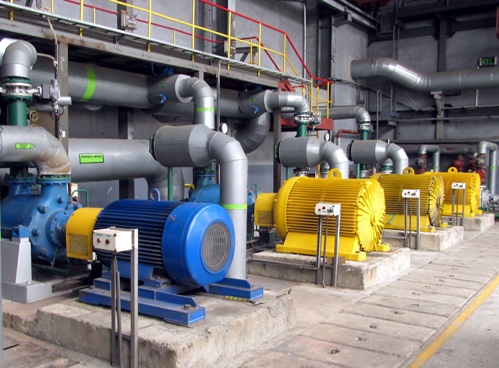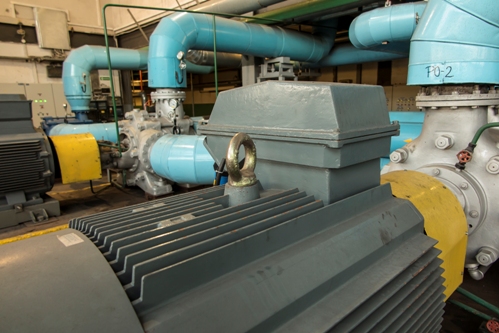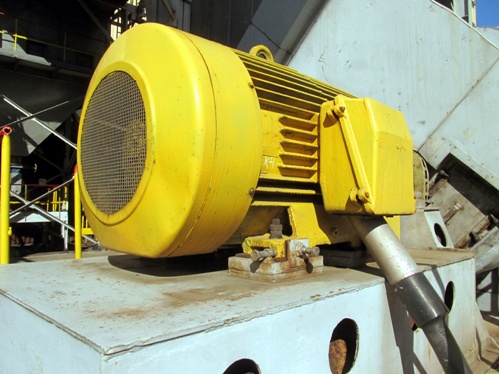Receivers of electrical energy
The receiver of electrical energy (electrical receiver) is an apparatus, unit, mechanism designed for conversion of electrical energy in a different type of energy (including electrical, according to other parameters) to use it.
According to their technological purpose, they are classified depending on the type of energy into which this receiver converts electrical energy, in particular:
-
mechanisms of drives of machines and mechanisms;
-
electrothermal and electrical plants;
-
electrochemical installations;
-
installation of electrode asthenia;
-
installations of electrostatic and electromagnetic fields,
-
electrofilters;
-
spark treatment installations;
-
electronic and computing machines;
-
product control and testing devices.
A user of electrical energy called an electrical receiver or a group of electrical receivers united by a technological process and located in a certain area.
The Federal Law "On Energy" defines the consumer of electricity and thermal energy as a person who purchases it for their own household or industrial needs, and the subjects of the electricity industry - "persons performing activities in the field of electric energy, including the production of electric and thermal energy, supply of energy to consumers "during electricity transmission, operational dispatch control in the electricity industry, electricity sales, organization of purchase and sale of electricity".

Classification of electricity consumers to ensure power supply reliability
In terms of ensuring the reliability of the power supply, consumers of electrical energy are divided into the following three categories:
Electrical receivers of category I - electrical receivers, the interruption of the power supply of which can lead to: danger to human life, significant damage to the national economy, damage to expensive basic equipment, massive product defects, disruption of a complex technological process, disruption of functioning of particularly important elements of the community's economy.
From the lineup electrical receivers of the 1st category a special group of electrical receivers is distinguished, the continuous operation of which is necessary for a smooth shutdown of production in order to prevent threats to human life, explosions, fires and damage to expensive main equipment.
Electrical receivers of category II - electrical receivers, the interruption of the power supply of which leads to a mass shortage of products, mass interruptions of workers, mechanisms and industrial transport, disruption of the normal activities of a significant number of residents of cities and rural areas.
Category III electrical receivers — all other electrical receivers that do not meet the definitions for Categories I and II. These are receivers of auxiliary workshops, non-serial production of products, etc.
Category I electrical receivers must be supplied with electricity from two independent mutually redundant power sources, and interruption of their power supply in the event of a power failure from one of the power sources can be allowed only for the time of automatic restoration of power supply. In order to supply a special group of electrical consumers of category I, an additional supply must be provided from a third independent mutually redundant power source.
In order to correctly establish the category of electrical receivers, it is necessary to assess the probability of an accident in the sections of the power supply system, to determine the possible consequences and material damage as a result of these accidents. When determining the category of electrical receivers, the category of continuous power required for different groups of electrical receivers should not be overestimated. When determining the electrical receivers for the first category, the technological reserve is taken into account, for the second - the displacement of production.
Classification of receivers of electrical energy
Electricity consumers are characterized by:
1.total installed power of electric receivers;
2. by belonging to the industry (e.g. agriculture);
3. by tariff group;
4. by category of energy services.
Electrical installations producing, transforming, distributing and consuming electricity are divided by voltage level into electrical installations with a voltage above 1 kV and up to 1 kV (for electrical installations with direct current — up to 1.5 kV). Electrical installations with a voltage of up to 1 kV AC are carried out with a solidly grounded neutral, and in conditions with increased safety requirements - with an isolated neutral (peat mines, coal mines, mobile electrical installations, etc.).
Installations above 1 kV are subdivided into installations:
1) with isolated neutral (voltage 35 kV and lower);
2) with compensated neutral (connected to the ground by inductive resistance to compensate for capacitive currents), are used for networks with a voltage of up to 35 kV and rarely 110 kV;
3) with a blindly grounded neutral (voltage 110 kV and more).
By the nature of the current, all electrical receivers operating from the network can be divided into electrical receivers with alternating current with an industrial frequency of 50 Hz (in some countries they use 60 Hz), alternating current with increased or decreased frequency and direct current.
Most of the electrical energy consumers of industrial electricity users operate on three-phase alternating current with a frequency of 50 Hz.
Increased frequency settings are used:
- for heating for hardening, for metal stamping, microwave ovens, etc.;
- in technologies where a high speed of rotation of an electric motor is required (textile industry, woodworking, portable power tools in aircraft construction), etc.
To obtain a frequency up to 10,000 Hz, thyristor converters are used, for frequencies above 10,000 Hz, use electronic generators.
Low-frequency electrical receivers are used in transport devices, for example for rolling mills (f = 16.6 Hz), in metal mixing plants in furnaces (f = 0 ... 25 Hz). In addition, the reduced voltage frequency is used in induction heating devices.
Experience with the use of industrial (50 Hz) and increased (60 Hz) frequencies confirmed the economic feasibility of a frequency of 60 Hz, and technical and economic calculations showed that the optimal frequency should be 100 Hz.
Typical power receivers
All power receivers are characterized by different parameters. At the same time, the modes of their operation are described by the LEG, therefore, for the purpose of analyzing the modes of energy consumption, characteristic power receivers are used, which are groups of power receivers similar in operation modes and basic parameters.
The following groups belong to typical electrical receivers:
- Electric motors for power and industrial installations;
- Electric motors for production machines;
- Electric ovens;
- Electrothermal installations;
- Lighting installations;
- Repair and conversion of installations.
Electrical receivers of the first four groups are traditionally called power receivers. The share of each group in the enterprise's energy consumption depends on the industry and the characteristics of the production process.
Direct current receivers
Direct current is used in electroplating (chrome plating, nickel plating, etc.), for direct current welding, for powering DC motors, etc.

Electric motors
Based on the classifications listed above, the most complex set of electric receivers is electric drive. The most common is an asynchronous electric drive, which is characterized by significant consumption of reactive power, high starting currents and significant sensitivity to deviations of the mains voltage from the nominal one.
In installations that do not require speed control during operation, AC electric drives (asynchronous and synchronous motors) are used. Unregulated AC motors are the main type of energy consumers in industry, accounting for about 70% of the total power.
The following considerations are often used when choosing the type of motor for an unregulated AC drive:
- at voltages up to 1 kV and power up to 100 kW, it is more economical to use asynchronous motors, and above 100 kW - synchronous;
- at voltage 6 kV and power up to 300 kW — asynchronous motors, over 300 kW — synchronous;
- at voltage 10 kV and power up to 400 kW — asynchronous motors, over 400 kW — synchronous.
Asynchronous motors with a phase rotor are used in powerful drives with severe starting conditions (in lifting machines, etc.).
The electric motors of such industrial installations as compressors, fans, pumps and lifting-transport devices, depending on the nominal power, have a supply voltage of 0.22-10 kV. The rated power of the electric motors of these installations varies from fractions of a kilowatt to 800 kW or more. The indicated electrical receivers usually refer to the I category of power supply reliability.For example, turning off the ventilation in chemical production workshops requires the evacuation of people from the premises and, therefore, a stoppage of production.
The conversion of alternating current to direct current requires the costs of installing conversion units and control equipment, building premises for them, as well as operating costs for their maintenance and loss of electricity. Therefore, the cost of the power supply system and the specific cost of electricity in direct current are higher than in alternating current. DC motors are more expensive than asynchronous and synchronous motors. Variable DC drives are used when a fast, wide and/or smooth speed change is required.

Power factor of electrical receivers
An important feature of an electrical receiver is Power factor cos (φn). The power factor is a passport characteristic reflecting the share of consumed active power at nominal load and voltage. The rated cosφ of an electric motor depends on its type, rated power, speed and other characteristics. When working with electric motors, their cosφ depends mainly on the load.
For the electric drive of large pumps, compressors and fans, synchronous motors are often used, which are used as additional sources of reactive power in the power system.
Lifting and transport devices are characterized by frequent shocks of the load, which cause changes in the power factor within significant limits (0.3-0.8). According to the reliability of the power supply, they usually refer to categories I and II (depending on their role in the technological process).
Troubled electrical receivers
From electrical devices The biggest problems are caused by arc furnaces for the following reasons:
- high own power (up to tens of megawatts); non-linearity and low cosφ caused by the furnace transformer;
- active and reactive power surges occurring during operation;
- jogging deviations from the symmetry of the phase loads.
AC electric welding plants have similar problems to arc furnaces. Their cosφ is particularly low.
Electric lighting also causes some problems with the electrical network, namely: high-efficiency discharge lamps used instead of incandescent lamps have a non-linear characteristic and are sensitive to short-term (fractions of seconds) power interruptions. Currently, however, these problems are solved by switching the lamps to a high-frequency power supply through separate frequency converters, which improves not only their lighting, but also their energy parameters.
Light sources (incandescent, fluorescent, arc, mercury, sodium, etc.) are single-phase electrical receivers and are evenly spaced across phases to reduce asymmetry. For incandescent lamps cosφ = 1, and for gas discharge lamps cosφ = 0.6.
The power supply of control and information processing devices is subject to increased requirements in terms of reliability and quality of electricity, therefore they are powered, as a rule, from sources of guaranteed uninterrupted power supply.
